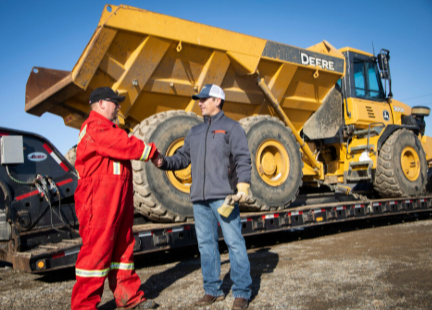7 Tips to Maximize Efficiency in Long-Distance Equipment Hauls

When hauling heavy equipment over long distances, efficiency isn’t just a bonus—it’s a necessity. Delays, mishaps, and inefficiencies can cost both time and money, so optimizing your hauling process is critical. Whether you’re transporting construction machinery, agricultural equipment, or industrial tools, planning ahead and using the right methods can make all the difference.
Here are seven actionable tips to help you maximize efficiency during long-distance equipment hauls.
1. Plan Routes Strategically
A well-planned route is essential for a smooth transport process. Use advanced GPS systems and route-planning tools to map your path, avoiding areas with traffic congestion, low bridges, or roadwork that could slow you down or cause detours.
For extra-large equipment, pay attention to road size restrictions and permits required for specific regions or states. Proper planning minimizes unexpected delays and helps you save on fuel costs.
2. Choose the Right Hauling Equipment
The equipment you use for transportation plays a critical role in efficiency. For heavy or oversized cargo, a lowboy trailer is often the best choice. These trailers are designed for transporting large, heavy items, thanks to their low deck height and sturdy construction.
Matching the right trailer to your load not only ensures safety but also prevents wear and tear on both the cargo and the machinery used for transportation. Selecting inadequate hauling equipment can quickly turn a straightforward job into an expensive ordeal.
3. Secure Permits in Advance
Every state has specific regulations for hauling large or heavy equipment, and failing to comply can result in fines, delays, or even equipment impoundment. When planning your haul, research all necessary permits and secure them ahead of time.
Oversize load permits, overweight permits, and escort vehicle arrangements may be required depending on the size and weight of your load. Avoid last-minute scrambling by having all the proper documentation in place before your departure.
4. Optimize Load Distribution
Properly distributed loads improve both efficiency and safety. Overloaded axles or uneven weight distribution can lead to vehicle instability, increased wear on tires, and even accidents.
Before hitting the road, ensure the load is secured properly and distributed evenly. Use load straps, chains, and tarps if necessary to prevent items from shifting during transit. A balanced load offers better control and reduces the risk of failure mid-journey.
5. Maintain Equipment Regularly
The condition of your transportation equipment directly impacts efficiency. Regular inspections and maintenance can prevent breakdowns, keep vehicles running smoothly, and prolong the lifespan of your hauling machinery.
Pay close attention to critical components like brakes, tires, suspension, attachments, and coupling mechanisms. Before long-distance trips, conduct a thorough inspection to identify and address potential issues. A breakdown during a haul can cause significant delays and added expenses.
6. Leverage Technology
Modern technology offers countless tools to make long-distance hauling more efficient. Fleet management apps, advanced GPS systems, and real-time tracking software can keep you updated on weather conditions, traffic changes, and overall vehicle performance.
Telematics solutions also help monitor fuel consumption and driver behavior, allowing you to adjust strategies to save resources and improve efficiency. By staying connected, you can address potential problems before they become major obstacles.
Read more: Self-Care Starts Here: How Massage Can Improve Your Overall Wellness
7. Train Drivers for Long-Distance Hauls
Your drivers are just as critical to efficiency as your equipment. Properly trained drivers understand the nuances of hauling large or heavy loads, including braking techniques, navigating tight spaces, and handling equipment on challenging terrains.
Provide ongoing training to your drivers to ensure they are familiar with all safety standards, loading procedures, and updated regulations. Skilled drivers directly contribute to minimizing delays and transportation risks.
Efficient long-distance hauls require meticulous planning, the right tools, and solid teamwork. By applying these strategies, you can streamline your process, reduce costs, and ensure your equipment arrives safely every time. With the right balance of technology, equipment, and expertise, long-distance equipment hauling can be both efficient and hassle-free.



